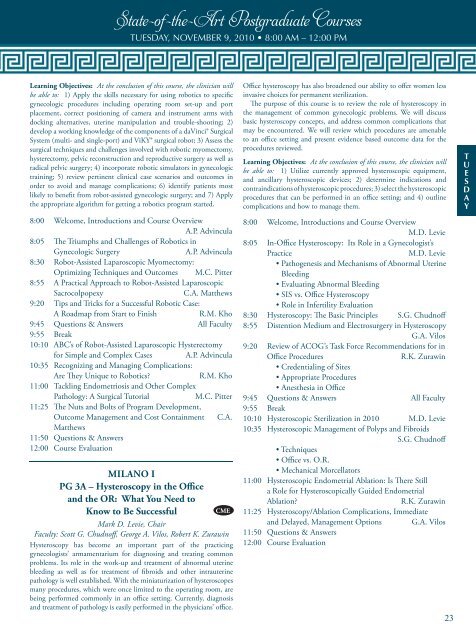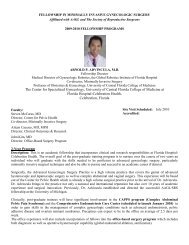39th AAGL Global Congress of Minimally Invasive Gynecology
39th AAGL Global Congress of Minimally Invasive Gynecology
39th AAGL Global Congress of Minimally Invasive Gynecology
You also want an ePaper? Increase the reach of your titles
YUMPU automatically turns print PDFs into web optimized ePapers that Google loves.
State-<strong>of</strong>-the-Art Postgraduate Courses<br />
TUESDAY, NOVEMBER 9, 2010 • 8:00 AM – 12:00 PM<br />
Learning Objectives: At the conclusion <strong>of</strong> this course, the clinician will<br />
be able to: 1) Apply the skills necessary for using robotics to specifi c<br />
gynecologic procedures including operating room set-up and port<br />
placement, correct positioning <strong>of</strong> camera and instrument arms with<br />
docking alternatives, uterine manipulation and trouble-shooting; 2)<br />
develop a working knowledge <strong>of</strong> the components <strong>of</strong> a daVinci® Surgical<br />
System (multi- and single-port) and ViKY® surgical robot; 3) Assess the<br />
surgical techniques and challenges involved with robotic myomectomy,<br />
hysterectomy, pelvic reconstruction and reproductive surgery as well as<br />
radical pelvic surgery; 4) incorporate robotic simulators in gynecologic<br />
training; 5) review pertinent clinical case scenarios and outcomes in<br />
order to avoid and manage complications; 6) identify patients most<br />
likely to benefi t from robot-assisted gynecologic surgery; and 7) Apply<br />
the appropriate algorithm for getting a robotics program started.<br />
8:00 Welcome, Introductions and Course Overview<br />
A.P. Advincula<br />
8:05 Th e Triumphs and Challenges <strong>of</strong> Robotics in<br />
Gynecologic Surgery A.P. Advincula<br />
8:30 Robot-Assisted Laparoscopic Myomectomy:<br />
Optimizing Techniques and Outcomes M.C. Pitter<br />
8:55 A Practical Approach to Robot-Assisted Laparoscopic<br />
Sacrocolpopexy C.A. Matthews<br />
9:20 Tips and Tricks for a Successful Robotic Case:<br />
A Roadmap from Start to Finish R.M. Kho<br />
9:45 Questions & Answers All Faculty<br />
9:55 Break<br />
10:10 ABC’s <strong>of</strong> Robot-Assisted Laparoscopic Hysterectomy<br />
for Simple and Complex Cases A.P. Advincula<br />
10:35 Recognizing and Managing Complications:<br />
Are Th ey Unique to Robotics? R.M. Kho<br />
11:00 Tackling Endometriosis and Other Complex<br />
Pathology: A Surgical Tutorial M.C. Pitter<br />
11:25 Th e Nuts and Bolts <strong>of</strong> Program Development,<br />
Outcome Management and Cost Containment C.A.<br />
Matthews<br />
11:50 Questions & Answers<br />
12:00 Course Evaluation<br />
MILANO I<br />
PG 3A – Hysteroscopy in the Offi ce<br />
and the OR: What You Need to<br />
Know to Be Successful<br />
CME<br />
Mark D. Levie, Chair<br />
Faculty: Scott G. Chudn<strong>of</strong>f , George A. Vilos, Robert K. Zurawin<br />
Hysteroscopy has become an important part <strong>of</strong> the practicing<br />
gynecologists’ armamentarium for diagnosing and treating common<br />
problems. Its role in the work-up and treatment <strong>of</strong> abnormal uterine<br />
bleeding as well as for treatment <strong>of</strong> fi broids and other intrauterine<br />
pathology is well established. With the miniaturization <strong>of</strong> hysteroscopes<br />
many procedures, which were once limited to the operating room, are<br />
being performed commonly in an <strong>of</strong>fi ce setting. Currently, diagnosis<br />
and treatment <strong>of</strong> pathology is easily performed in the physicians’ <strong>of</strong>fi ce.<br />
Offi ce hysteroscopy has also broadened our ability to <strong>of</strong>f er women less<br />
invasive choices for permanent sterilization.<br />
Th e purpose <strong>of</strong> this course is to review the role <strong>of</strong> hysteroscopy in<br />
the management <strong>of</strong> common gynecologic problems. We will discuss<br />
basic hysteroscopy concepts, and address common complications that<br />
may be encountered. We will review which procedures are amenable<br />
to an <strong>of</strong>fi ce setting and present evidence based outcome data for the<br />
procedures reviewed.<br />
Learning Objectives: At the conclusion <strong>of</strong> this course, the clinician will<br />
be able to: 1) Utilize currently approved hysteroscopic equipment,<br />
and ancillary hysteroscopic devices; 2) determine indications and<br />
contraindications <strong>of</strong> hysteroscopic procedures; 3) select the hysteroscopic<br />
procedures that can be performed in an <strong>of</strong>fi ce setting; and 4) outline<br />
complications and how to manage them.<br />
8:00 Welcome, Introductions and Course Overview<br />
M.D. Levie<br />
8:05 In-Offi ce Hysteroscopy: Its Role in a Gynecologist’s<br />
Practice M.D. Levie<br />
• Pathogenesis and Mechanisms <strong>of</strong> Abnormal Uterine<br />
Bleeding<br />
• Evaluating Abnormal Bleeding<br />
• SIS vs. Offi ce Hysteroscopy<br />
• Role in Infertility Evaluation<br />
8:30 Hysteroscopy: Th e Basic Principles S.G. Chudn<strong>of</strong>f<br />
8:55 Distention Medium and Electrosurgery in Hysteroscopy<br />
G.A. Vilos<br />
9:20 Review <strong>of</strong> ACOG’s Task Force Recommendations for in<br />
Offi ce Procedures R.K. Zurawin<br />
• Credentialing <strong>of</strong> Sites<br />
• Appropriate Procedures<br />
• Anesthesia in Offi ce<br />
9:45 Questions & Answers All Faculty<br />
9:55 Break<br />
10:10 Hysteroscopic Sterilization in 2010 M.D. Levie<br />
10:35 Hysteroscopic Management <strong>of</strong> Polyps and Fibroids<br />
S.G. Chudn<strong>of</strong>f<br />
• Techniques<br />
• Offi ce vs. O.R.<br />
• Mechanical Morcellators<br />
11:00 Hysteroscopic Endometrial Ablation: Is Th ere Still<br />
a Role for Hysteroscopically Guided Endometrial<br />
Ablation? R.K. Zurawin<br />
11:25 Hysteroscopy/Ablation Complications, Immediate<br />
and Delayed, Management Options G.A. Vilos<br />
11:50 Questions & Answers<br />
12:00 Course Evaluation<br />
23<br />
T<br />
U ES<br />
D AY







